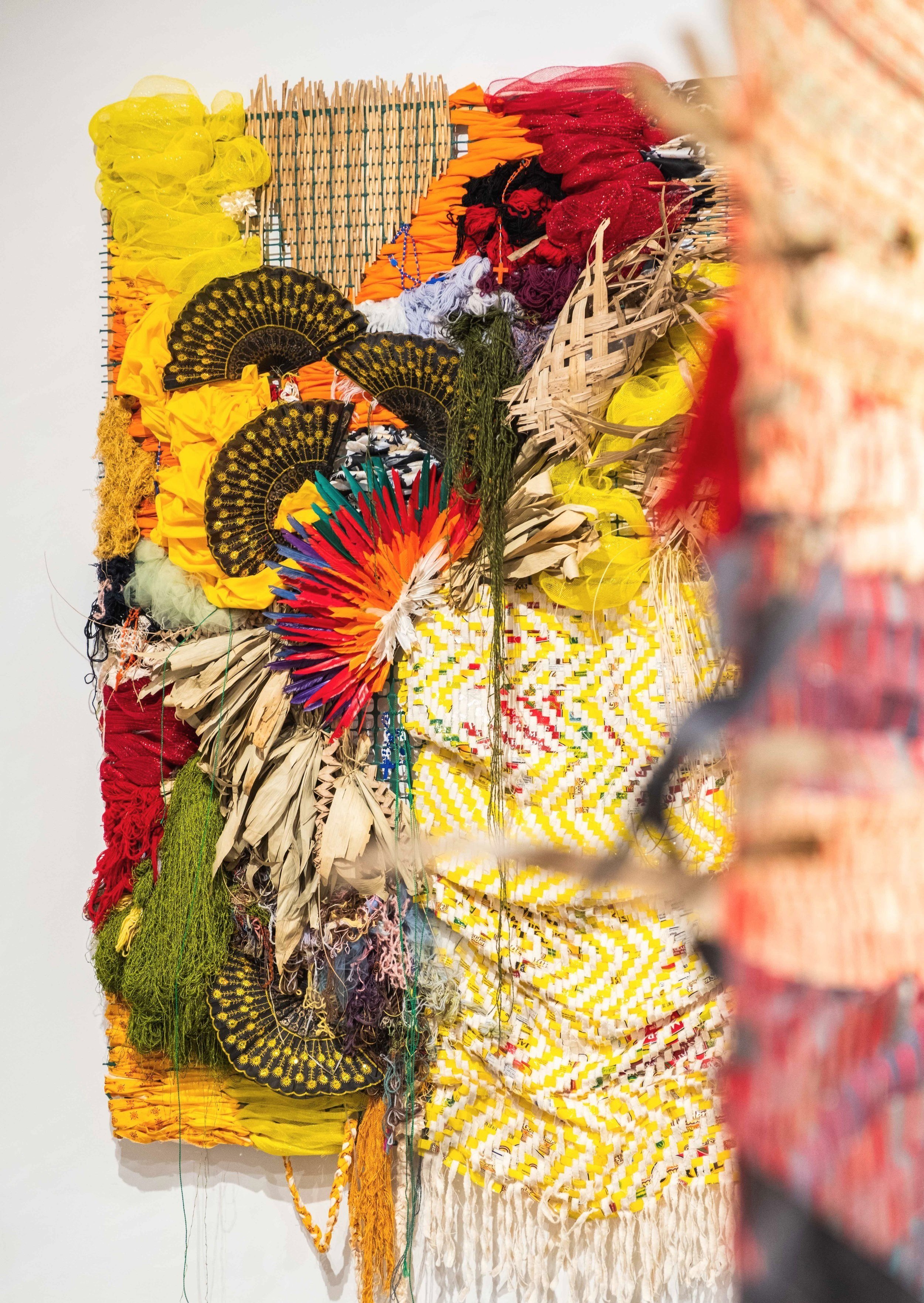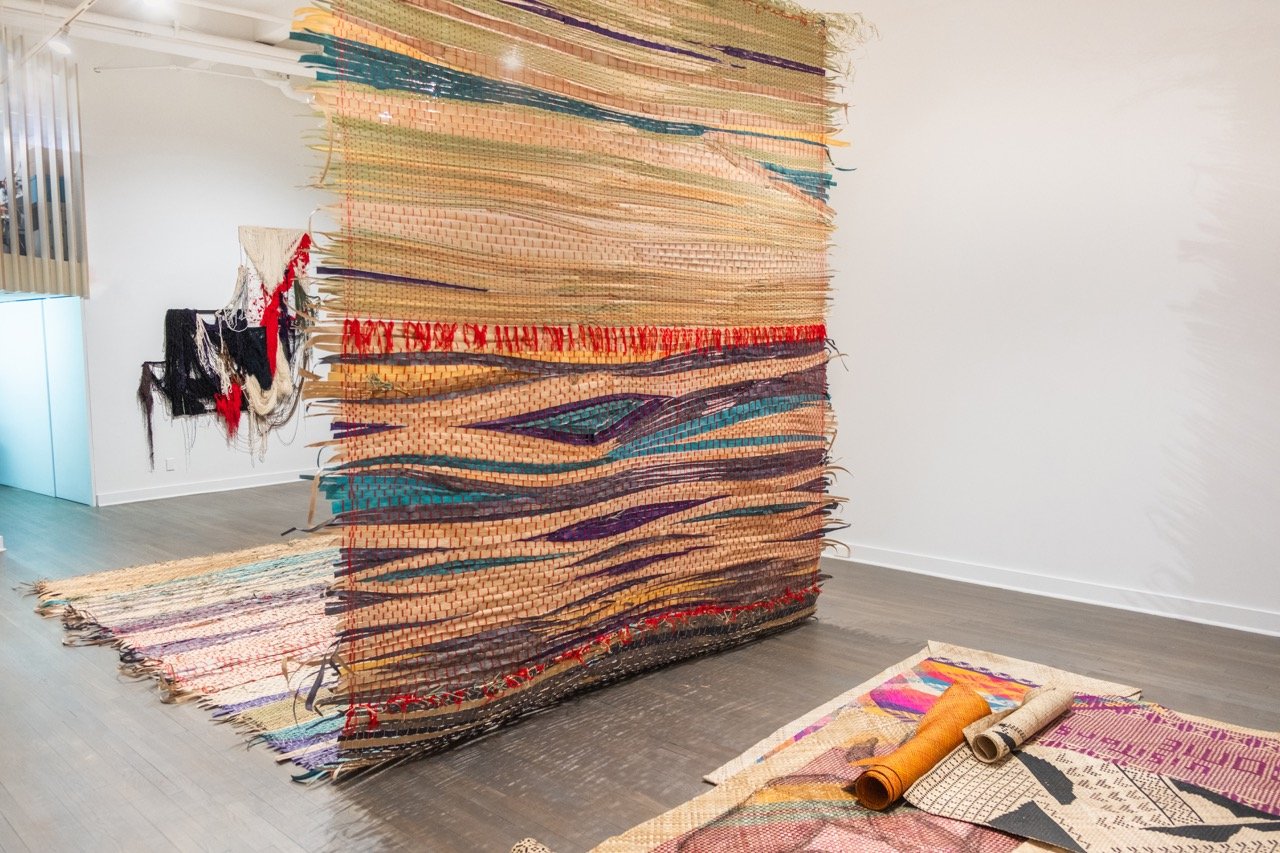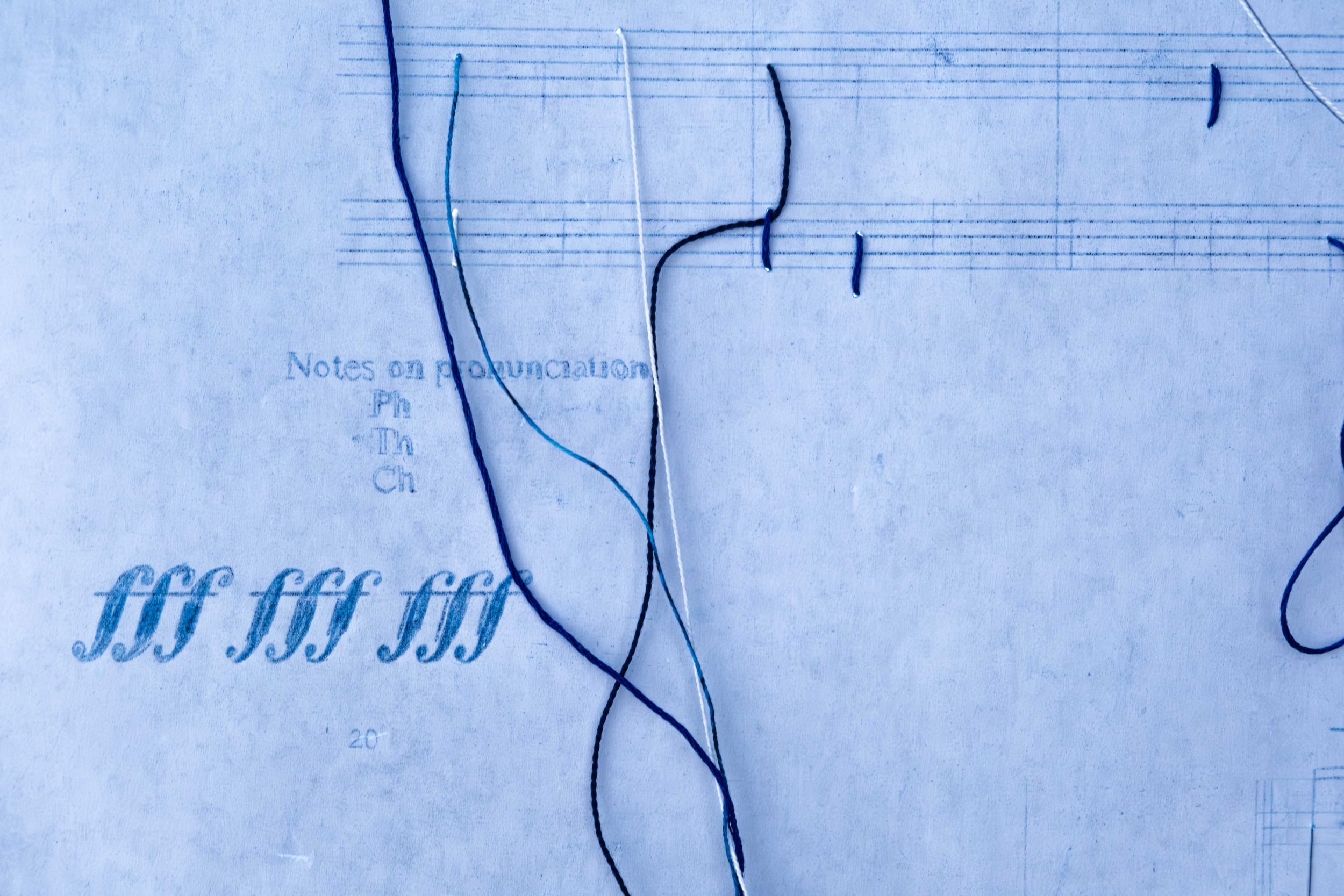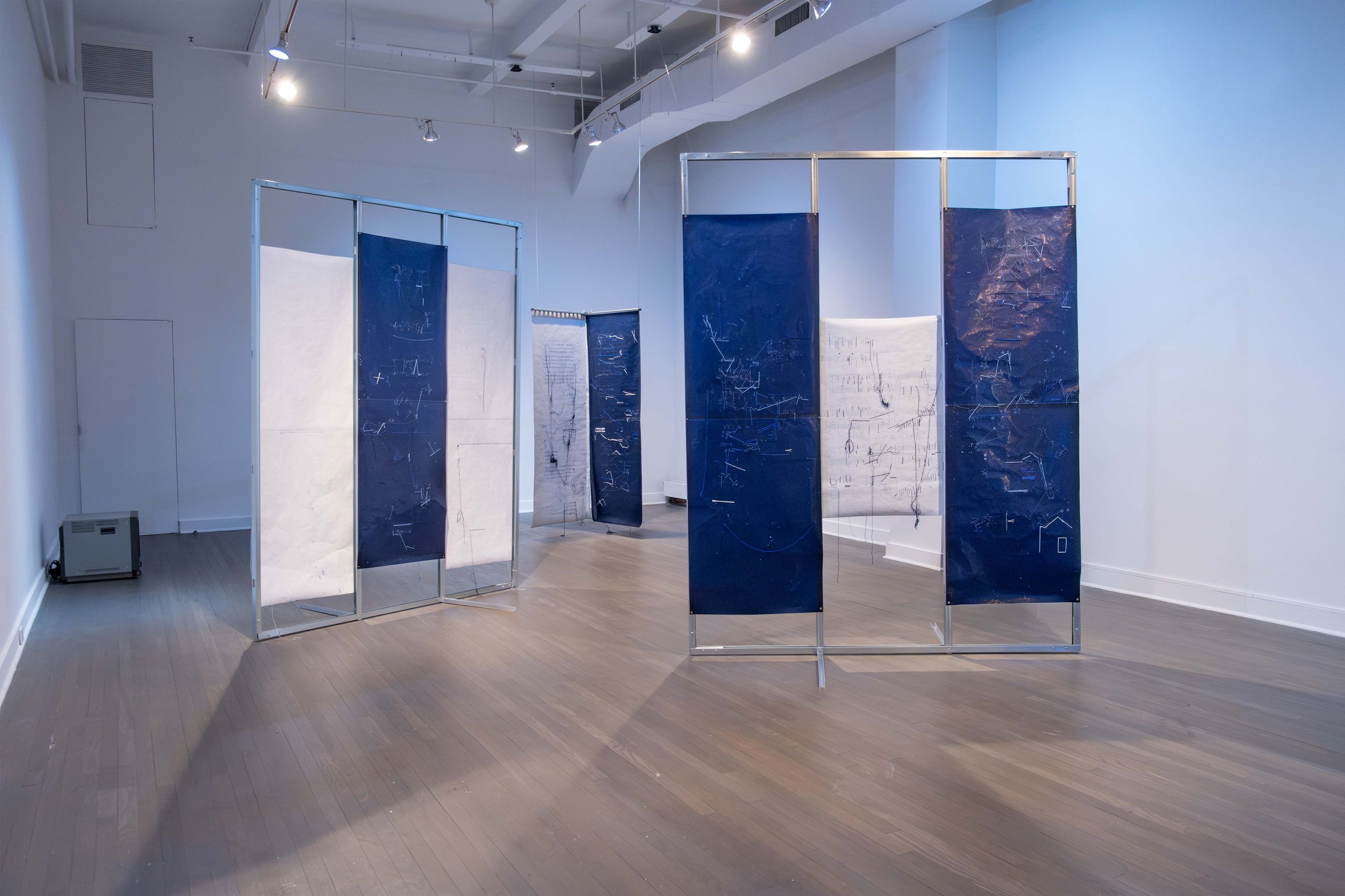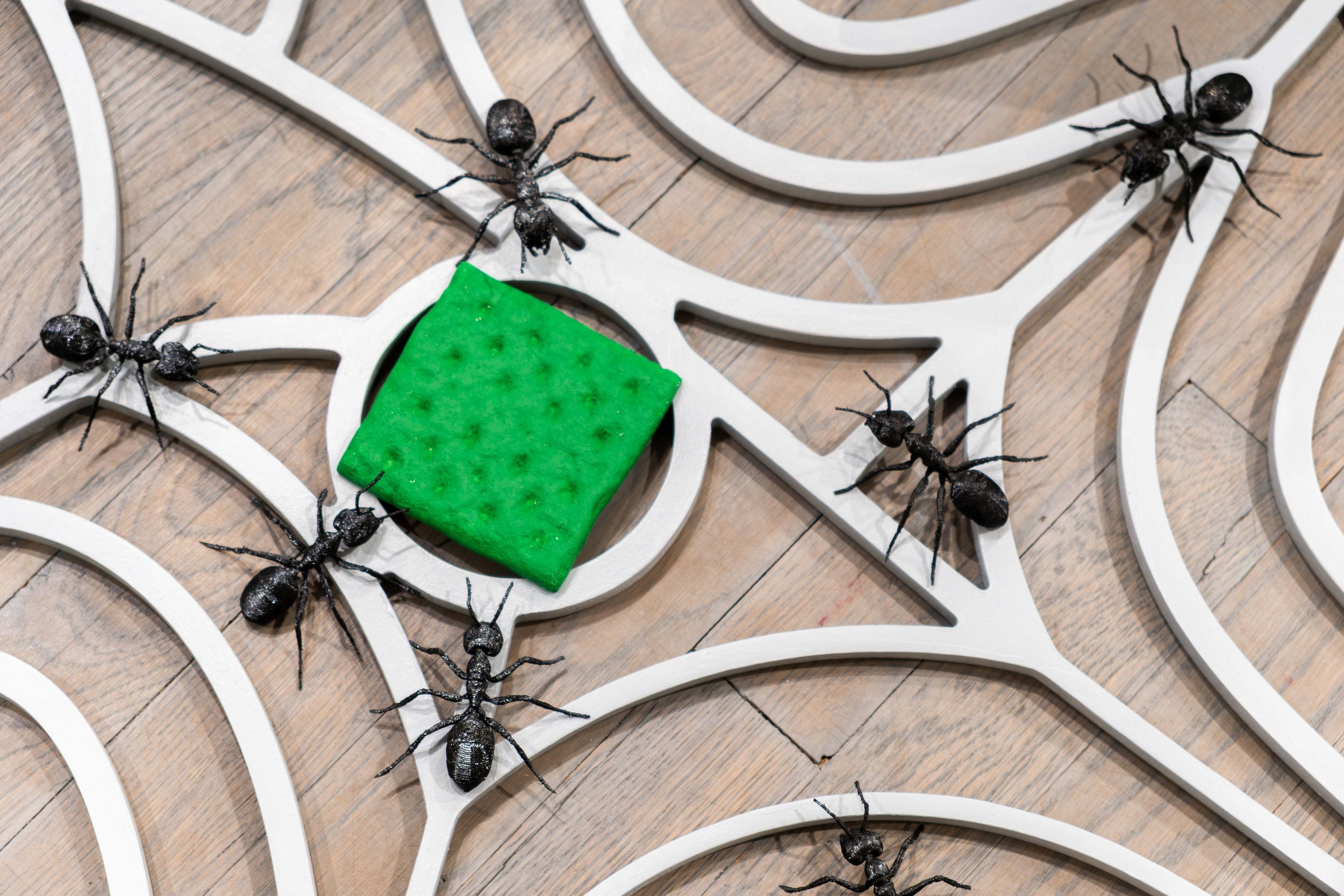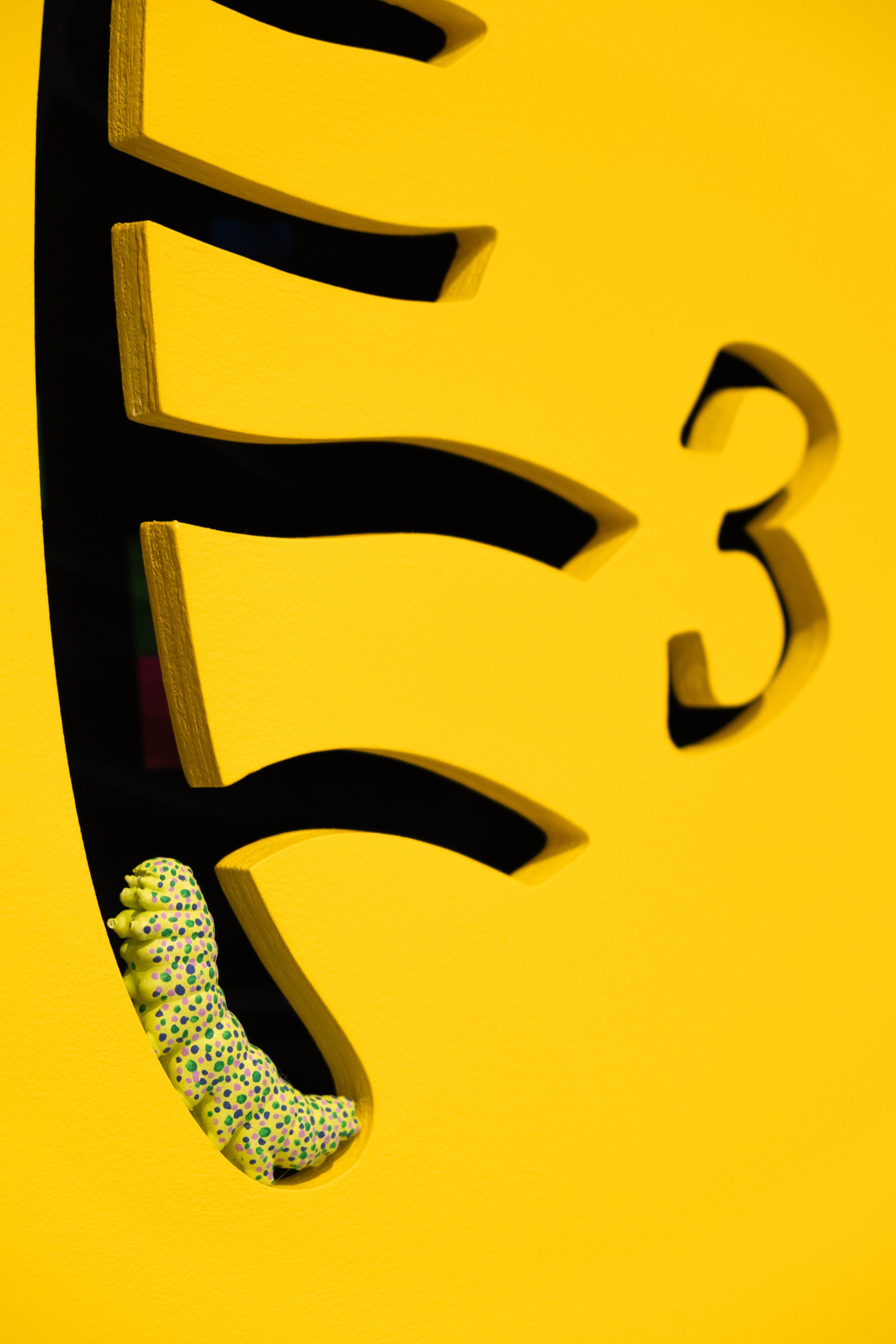Writer: Tsovinar Kuiumchian
Essay Mentor: Kim Córdova
This essay was produced in conjunction with the exhibition The Bride Has Gone to Pick Flowers, curated by Lila Nazemian, mentored by Martha Joseph, and on view at CUE Art from January 30 – May 10, 2025. The text was commissioned as part of CUE’s Art Critic Mentorship Program, and is included in the free exhibition catalogue available at CUE and online.
Installation view of The Bride Has Gone to Pick Flowers, curated by Lila Nazemian with works by Levon Kafafian, Fatemeh Kazemi, and Levani, 2025. Photo by Leo Ng.
What remains of tradition when it is neither preserved as a static artifact nor entirely rejected, but instead inhabited and reimagined? The group exhibition The Bride Has Gone to Pick Flowers, curated by Lila Nazemian at CUE Art, offers a series of artistic interventions that address this question while centering intersectional diasporic voices from the Caucasus. Spotlighting the archetypal figure of the bride as a conduit of tradition, artists Levon Kafafian, Fatemeh Kazemi, and Levani deploy site-responsive multimedia installations, participatory art, and performance to explore the notion of marriage—not as a clear-cut passage or a bedrock of social and gender norms, but as a transformative space of projection, refusal, and possibility.
Located on the cusp of Europe and Asia, the Caucasus is commonly framed as a perennial battleground for the Persian, Ottoman, and Russian empires and their successors, as well as a subject of the forces of European colonialism—each vying for influence over a strategically significant geographic and cultural crossroads. The exhibition, however, refuses a reading of the region through the lens of passive political domination. Mobilising their deep-seated local and diasporic ties to Iran, Armenia, and Georgia, the curator and the artists upend contemporary Western understandings of culture, gender, and modernity in the Caucasus by foregrounding lived experience, collective memories, and speculative imagination.
The exhibition draws upon the region’s long history of spiritual, erotic, and aesthetic fluidity. Afsaneh Najmabadi’s seminal text Women with Mustaches and Men Without Beards: Gender and Sexual Anxieties of Iranian Modernity (2005) explores the enduring literary and visual canon of Iran’s Qajar era (1786–1925), when the boundaries between femininity and masculinity were often considered to be negotiable and contested. This fluidity is materialised in Sergei Parajanov’s 1969 film The Colour of Pomegranates; the protagonists—legendary Armenian medieval ashugh Sayat-Nova and his lover, the Georgian princess Ana—are portrayed by one person, the actress Sofiko Chiaureli. Likewise, in Persian miniatures, depictions of lovers make them almost indistinguishable from one another—an effort to express the essence of profound spiritual union.
Contemporary artists from the Caucasus continue to challenge the binarisation of gender in the region—a dynamic that proliferated with the imposition of Western and Russian colonial moralities, as well as through the influence of European realistic representation and the advent of camera technology. Morehshin Allahyari’s screen-based work ماه طلعت (Moon-faced, 2022), for example, recovers queer representation from historical Iranian portraiture in collaboration with artificial intelligence. Contextual understandings of gender in the region became increasingly obscured with the rise of reactionary modern nationalisms, which—intertwined with religious doctrines—reinforced gender divisions through notions of purity and taboo. This confluence reveals a persistent entanglement of the body, sexuality, morality, and governance that ultimately manifested in patriarchal visions of the bride, whose passage into marriage entails her separation from her family of origin in the name of initiating new familial and social ties. The ritual demurral of the bride before her inevitable elopement—expressed in the title of the show at CUE—serves primarily as a reinforcement of the prescribed new order.
The Bride Has Gone to Pick Flowers invites us to inhabit that moment of delay. The show opens with Fatemeh Kazemi’s Yüreğimde yalancılığın hançeri (“The dagger of lies in my heart,” 2025), executed in cast aluminium, chain, and tassels. It partitions the city and the gallery space, greeting the visitor at a threshold, with its subtle revolutions introducing suspension as a central gesture in the exhibition. Kazemi’s Dünya Mest Olmuş (“The World is Enchanted,” 2025), a site-specific bas-relief poem illuminated in a violet glow, envelops the passageway toward the principal exhibition space, which forms the “dreamscape” of the saqi—Kazemi’s artistic alter ego, a gender-fluid cupbearer from Persian poetic tradition. The saqi distills a local version of arak cultivated from raisins—an intoxicating substance that nurtures transcendence, away from the limits of the rational mind. Recounting the steps as well as the trials and tribulations of fermentation, the work hints at the labor of domesticity and hospitality—and at the kitchen as a semi-private space of transformation, experiment, encounter, and knowledge exchange.
Fatemeh Kazemi, Saqi, 2024-25, part of the series Dünya Yalan Dünyasi (The World: A World Full of Lies). Photo by Leo Ng.
Further assuming the persona of her alter ego, Kazemi presents the installation work Saqi (2024-25). In the work, she sifts through collective memories of fluidity, reverberating in the androgynous depiction of womanhood present in a portrait produced by a street artist in Tehran upon her request. The work introduces a roseate partition screen upon which appears a repeated digital print of the portrait alongside images from Kazemi’s family archive, with one depicting a perhaps accidental, but equally ambiguous embrace between two masculine presenting figures. The work is embedded with digital monitors featuring verses by Kashmiri poet Agha Shahid Ali. It foregrounds the continuous negotiation of boundaries between private and public—now also in the digital realm—which are fundamentally disobedient and ungovernable.
Kazemi complements these works with the staging of a one-night performative dinner in the gallery alongside the food collective Bazm, a feast based on the premise of a wedding party waiting for the missing bride. Here, her final work in the show, Yalan Dünya (“A World of Lies,” 2025) becomes activated as part of a sofreh aghd (wedding spread). Upon a platform rests a sugar encrusted chair with heart-shaped sugar cubes engraved in clove powder with the title of the work—a nod to the Iranian tradition of married women rubbing sugar above the heads of newlyweds to wish them a sweet life. During the dinner, the bride is absent, but is no longer instrumentalised as a conduit; it is the artist-as-cupbearer’s service that transforms the gathering into a space of communal intimacy and connection.
The act of evoking mythical and fabulated entities that displace the figure of the bride is also visible in Levon Kafafian’s Mirror of Fate (2025)—a floor-to-ceiling emerald-coloured installation evoking an altar, and crafted from hand-dyed silks decorated with intricate beadwork. Referencing Armenian liturgical textiles and medieval manuscripts, this altar centers the speculative character Anarad, a feminine serpentine spirit who governs time in Azadistan (azad means “free” in Armenian and many other SWANA and South Asian languages)—an imagined world that is part of a long-term multimedia project by Kafafian, spanning many of their works. Contrasting the typical patriarchal symbolism often present in a Christian altar, Kafafian reclaims the sacred space for feminine autonomy. Anarad is neither bride nor priestess, but a sovereign figure suspended in-between. She is unpartnered by her own choice (and, in fact, chooses to marry herself), embodying the “essence of refusal,” according to the artist.
Levon Kafafian, Mirror of Fate, 2025. Photo by Leo Ng.
Comprised of several further titled works, including Pools of Liquid Time and Heart of the Serpent, Kafafian’s installation is partly inspired by the Armenian spring holiday of hampartsum—during which young girls perform vijagakhagh, a fortune-telling ritual in which they collect water from seven different springs and submerge within it herbs, flowers, and personal items that are then interpreted into predictions about their romantic futures. Kafafian invites gallery visitors into this ritual, making space at the foot of a textile piece titled The Scrying Pool to divine their futures while meditating upon the unstated and the unknown of their deep ancestral pasts. For the artist, a “multidirectional gazing through time” allows for the apprehension of our existence “in context, in relation, in network”—an approach that is shared by other artists and thinkers in the emerging Armenofuturist movement, including Mashinka Firunts Hakopian, Hrag Vartanian, Dahlia Elsayed, Andrew Demirjian, and Kristin Anahit Cass, among others. Kafafian further contributes to this legacy with Khorurt Anaradi, a handmade book containing poems, song lyrics, and other writing in a new future-adapted script created by the artist for Azadistan, evolving from endangered Western Armenian language.
Inviting a sense of multidirectional temporality, Kafafian also commissions an immersive composition by electronic musician and sound artist Lara Sarkissian, with wandering microtonal melodies and resonant echoes of the churches of the Armenian Highlands. Interwoven with elemental sounds of nature, the composition evokes a sense of temporal suspension, alluding to Kafafian's early experiences in Armenian diaspora churches—where incense, chant, and ornament create a space in which “time does not exist.” This poignant multimedia collaboration further unveils the potential for tradition to serve as a site of transcendence and futurity.
The work of Levani (the artistic name of Levan Mindiasvhili) resonates with this vision while fragmenting it into a dissonant, post-organic key emanating from the cultural framework of contemporary and prehistoric Georgia. An installation work evoking the bride’s boudoir, ii. the priestexx [bride] (2025), is loosely anthropomorphic and techno-futuristic: a recumbent assemblage of carefully selected and designed material forms a composite being that evokes a bride who doubles as a warrior. The figure is constructed with a gazelle horn and 3D printed replica at the apex, along with 3D printed “fungus” earrings and hand-hammered copper armored underwear by Georgian designer Godera, a cast silicone “heart,” and various brass and stone elements—including two cuboid volumes that evoke prosthetic legs, made with stone from the rural Georgian region of Tusheti. Reflected in a partly obscured mirrored panel and united together by a neon tube that serves as a “vertebrae” of sorts, the work invokes Sumerian cosmology and pre-Christian Georgian spirituality—undoing dichotomies of synthetic and organic, man-made and naturally produced. It also formally recalls Marcel Duchamp’s The Bride Stripped Bare by Her Bachelors, Even (1915-1923), a seminal artwork of the twentieth century. In Duchamp’s work, two glass cases with lead wire, lead foil, oil, and dust become abstract domains of a bride and her suitors—a commentary on alienated desire in the era of militarism and mechanisation. Though these works share fragmented, hybrid forms to challenge traditional representations of gender, Levani’s work nonetheless holds faith in the transformative potential of union.
Levani, ii. the priestexx [bride], 2025. Photo by Leo Ng.
With its rich layering of material and references, Levani’s practice disrupts ceremonial logic and stages a form of ritual animated by elemental tension—dwelling comfortably in the indeterminacy and the riddle that the Caucasus represents for many outside of the region. In the altar (2025), a glowing projection of the sun hovers between two androgynous totems, v. the hierophant i and v. the hierophant ii (2025). Between them and below the sun sits the well (2025), a basin of pink marble made in collaboration with sculptor Papuna Dabrundashvili and filled with ink and water. Above the basin is a speaker that transmits sound recorded by artist Marika Kochiashvili of the ongoing protests in Georgia against political repression and governmental corruption, particularly in response to the controversial 2024 elections and the reprisal of an authoritative state. According to Levani, the conjoining of elemental forces in the work serves as a prayer for the safety of the protesters; the “precognitive” totemic references conjure a sense of hope in unsettling present-day narratives—in generating enough “errors of perception” that a reconciliation of the ancient with the future will be possible.
The Bride Has Gone to Pick Flowers is a multifaceted assertion—of fluidity as a foundational element of cultural production in the Caucasus and beyond, and of ritual as a lens through which to examine the region and its diasporas as living, dynamic entities that resist the monolithic agendas imposed upon them. As curator Lila Nazemian notes, queer diasporic artists often face expectations in their Western host communities to inhabit a form of queerness that is divorced from knowledge and meanings that draw from their ancestral cultures. This Western universalist perspective on queerness frequently upholds an ideal of purity that is unsettled by the very notion of “tradition,” as well as by non-Western histories and practices of queerness—resulting in a dynamic of persistent othering discussed by Edward Said in the seminal Orientalism (1978). The exhibition serves as a counter to this dynamic, presenting a wide-ranging critique that locates sacrifice, submission, and the subtle violences of matrimony not only within patriarchal traditions of the Caucasus, but also within broader societal mechanisms of social cohesion on global and local scales.
The queering of matrimonial tradition put forth by the exhibition premise gives rise to new forms of liberatory artistic expression, and creates a rich context of cultural hybridity, contact, and transformation described as a “Third Space” by Homi Bhabha in The Location of Culture (1994)—one where homogeneity cannot be imposed. Dwelling in a moment of delay, The Bride Has Gone to Pick Flowers subverts the linear logic of “progress,” challenging the assumption that ritual enacts a clear passage from one state of being to another, and instead centering the ambiguous, disorderly, and durational nature of ritual transformation—and of culture itself. Through diverse forms of material engagement with the texture of transformation—social, political, and spiritual—the works of Kazemi, Kafafian, and Levani come together to reclaim this ambiguity as a generative force for intimacy, kinship, cultural production, and liberation.
About the Writer
Tsovinar Kuiumchian is a doctoral candidate at the School of Anthropology and Museum Ethnography, University of Oxford. Her research draws from the intersection of visual, material, and museum anthropology with political anthropology to examine the social and political significance of contemporary art and creative practices in the global Armenian community. She conducts her multi-sited ethnography in the US, Europe, Turkey, and Armenia.
Tsovinar has contributed to public discourse about contemporary art in writing and interviews that include collaborations with Armenian diaspora artists Kristin Anahit Cass (for the publication Reparations of the Heart) and Levon Kafafian (for the Museum of Contemporary Art Detroit), as well as with AHA Collective for its Living Portals exhibition in Armenia. Part of the Armenian diaspora, she was born and raised in Ukraine.
About the Writing Mentor
Kim Córdova served as a mentor for this essay. Córdova is a Mexican American culture journalist and independent curator. Her work is focused on analyzing power, politics, and technology’s impacts on society through art and cultural institutions. Córdova has contributed to exhibitions at several institutions, including the Museo Franz Meyer, CCS Wattis, Spike Quarterly, and Museo de Arte Zapopan. She is a contributor to numerous publications, including The New York Times, ArtForum, e-flux, October, SFMoMA, and Momus, where she was the Mexico City Contributing Editor (2016-2020). She is a 2023 recipient of the Andy Warhol Foundation Art Writer Grant, and her work has twice been shortlisted for the International Award for Art Criticism. She is a Zhi Xing China Eisenhower Fellow, a German Marshall Fund Marshall Memorial fellow, and a Fulbright Scholar. Córdova holds a master's degree from Harvard and is a graduate of the Programa Educativo Soma in Mexico City.
About the Art Critic Mentorship Program
This text was written as part of the Art Critic Mentorship Program, a partnership between CUE and the AICA-USA (the US section of International Association of Art Critics). The program pairs emerging writers with art critic mentors to produce original essays about the work of artists exhibiting at CUE. Learn more about the program here. No part of this essay may be reproduced without prior written consent from the author.











![Levani, Detail of ii. the priestexx [bride] , 2025. Photo by Leo Ng.](https://images.squarespace-cdn.com/content/v1/51f13e79e4b0799d35dfa1a8/1745699678219-WUBY7FDYOEER9KKR59XR/35.+Levani%2C+Detail+of+ii.+the+priestexx+%5Bbride%5D%2C+2025.+Photo+by+Leo+Ng..jpg)
![Levani, Detail of ii. the priestexx [bride] , 2025. Photo by Leo Ng.](https://images.squarespace-cdn.com/content/v1/51f13e79e4b0799d35dfa1a8/1745699719647-84A9IZKGJWOQMAPNMZA3/33.+Levani%2C+Detail+of+ii.+the+priestexx+%5Bbride%5D%2C+2025.+Photo+by+Leo+Ng..jpg)

















